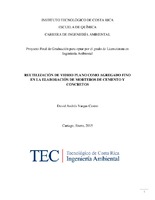Reutilización de vidrio plano como agregado fino en la elaboración de morteros de cemento y concretos
Resumen
There has been an increase in use of flat glass in the Construction sector, which generates as a consequence a rise in the amount of its waste, ending in their mayority in landfills even though this is not the most optimal disposal of these residues. Therefore, it is proposed as objective of this project to evaluate the re-use flat glass waste as a partial replacement of the fine aggregate for making cement mortar and concrete; due the nature of the glass it is potentially reusable in the construction sector. For this investigation, three types of flat glasses were evaluated (reflective glass [V-R], mirror glass [V-E] and 6 mm clear glass[V-I]) in which 4 mixtures were performed for mortars and other 4 for concretes in a defined proportion of sand and ground glass as fine aggregate, each type of flat glass was used in a mixture and also a standard [P]. Subsequently, tests of their resistance to compression at different ages were made. In the mortar, the resistances obtained at age of 28 days in the samples with glasses were higher compared with the standards samples (V-E of 462 kg/cm2, V-R of 440 kg/cm2, V-I of 409 kg/cm2 y P of 390 kg/cm2); making possible the realization of these types of mortars and also it makes some decorative effects. In concretes, the resistance to compression was not affected with the presence of flat glass and remained similar among all the mixtures samples (V-E of 307 kg/cm2, V-R of 308 kg/cm2, V-I of 313 kg/cm2 y el P of 311 kg/cm2). A comparison of the cost of making concrete with flat glass as fine aggregate and the standard concrete was made, as a result of this comparison the mixtures cost is similar in all the cases, but the concrete with flat glass can cost approximately 1% less than the standard concrete.
Descripción
Proyecto de Graduación (Licenciatura en Ingeniería Ambiental) Instituto Tecnológico de Costa Rica, Escuela de Química, 2015.


